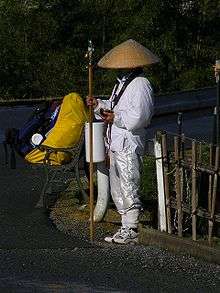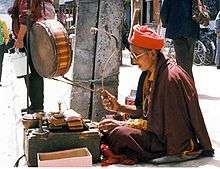Mendicant
A mendicant (from Latin: mendicans, "begging") is one who practices mendicancy and relies chiefly or exclusively on alms to survive. In principle, mendicant religious orders own little property, either individually or collectively, and in many instances members have taken a vow of poverty, in order that all their time and energy could be expended on practicing their respective faith, preaching and serving society.

Mendicancy is a form of asceticism.
Religious practice
Many religious orders adhere to a mendicant way of life, including the Catholic mendicant orders, Hindu ascetics, some Sufi dervishes of Islam, and the monastic orders of Jainism and Buddhism.
While mendicants are the original type of monks in Buddhism and have a long history in Indian Hinduism and the countries which adapted Indian religious traditions, they did not become widespread in Christianity until the High Middle Ages. The Way of a Pilgrim depicts the life of an Eastern Christian mendicant.
Christianity
_(14597327508).jpg)
Early Church
Mendicancy in Christianity has its roots in the Bible. In the Gospel of Mark, Jesus is described as granting his apostles a “gift of tongues”. This is later expanded upon in Luke’s Acts of the Apostles, where it allows them to be understood by anybody regardless of the language of the person being spoken to.
Early 1st Century New Testament figures such as John the Baptist[1] and Paul of Tarsus were also known for extensively traveling and preaching the Gospel to unreached peoples in the Middle East and Europe, although often staying for longer periods than modern itinerant evangelists.
Roman Catholicism
In the early Latin Rite church, mendicants and itinerant preachers were looked down upon, and their preaching was suppressed. In the Rule of Saint Benedict, Benedict of Nursia referred to such traveling monks as gyrovagues, and accused them both of indulging their wills, and of being particularly subject to the sin of gluttony.
In the early 13th century, the Catholic Church would see a revival of mendicant activity, as followers of Saint Francis of Assisi and Saint Dominic begged for food while they preached to the villages. These men came to found a particularly Catholic form of monastic life referred to as mendicant orders. These orders were in stark contrast to more powerful, and more conservative, monastic orders such as the Benedictines and Cistercians.
Itinerant preachers that belonged to mendicant orders traveled from town to town to preach the Gospel, consciously modeling themselves after Jesus and the Twelve Disciples. Professor Giacomo Todeschini at the University of Trieste has described these mendicants in the following way:[2]
"The choice to be poor was realized in a series of gestures: abandonment of one's paternal house, a wandering life, ragged appearance and clothes, manual work as scullery-man and mason, and begging without shame."
Other Christians
Unlike the Western Church, Eastern Christians never created a form of monasticism equivalent to mendicant orders. Rather, all Orthodox monks and nuns follow the more traditionally monastic Rule of Saint Basil.
Despite the abandoning of monastic practice within Protestantism, mendicant preaching has still come about independently of it. American Methodists were once known for sending out itinerant preachers known as circuit riders. The Mormons are particularly well-known for sending their members on proselytizing missions away from home.
Buddhism

Buddhism is one of several religious traditions of ancient India that has an established practice of mendicancy. Monks of the Theravada traditions in Southeast Asia continue to practice alms round (Sanskrit and Pali: piṇḍapāta) as laid down by the Buddha. Food is procured from the faithful and divided equally among all members of the Sangha.
A major difference between Buddhist and Christian mendicancy is the understanding of manual labor as a means of support. While many Buddhist communities formulated limited forms of labor for monks, there also exists the understanding that a Buddhist monk must remain aloof from secular affairs.[3] Many of these rules of decorum and acceptable livelihood are preserved in the Vinaya literature of several schools. The Sangha's immersion into the work of laymen and laywomen is also believed to be a sign of impending calamity.[4]
Theravada
Buddhist literature details the code of behavior and livelihood for monks and nuns, including several details on how mendicancy is to be practiced. Traditionally, mendicants relied on what have been termed the "four requisites" for survival: food, clothing, lodging, and medicine. As stated in the Theravada Vinaya:[5]
"Properly considering the robe, I use it: simply to ward off cold, to ward off heat, to ward off the touch of flies, mosquitoes, simply for the purpose of covering the parts of the body that cause shame.
"Properly considering almsfood, I use it: not playfully, nor for intoxication, nor for putting on weight, nor for beautification; but simply for the survival and continuance of this body, for ending its afflictions, for the support of the chaste life, (thinking) I will destroy old feelings (of hunger) and not create new feelings (from overeating). Thus I will maintain myself, be blameless, and live in comfort.
"Properly considering the lodging, I use it: simply to ward off cold, to ward off heat, to ward off the touch of flies, mosquitoes, wind, sun and reptiles; simply for protection from the inclemencies of weather and for the enjoyment of seclusion.
"Properly considering medicinal requisites for curing the sick, I use them: simply to ward off any pains of illness that have arisen and for the maximum freedom from disease."
In addition, a monk's personal property was also limited. The Theravada tradition recognizes eight requisites (Pali: aññha parikkhàra):[6]
- Uttarāsaṅga (outer robe)
- Antarvāsa (inner robe)
- Saṃghāti (double robe)
- an alms bowl
- a razor for shaving
- a needle and thread
- a belt
- a water strainer
Commentarial literature provides additional possessions based on circumstance.
Japanese Buddhism
Similar to the development of Buddhism in China, the Japanese did not frequently engage in alms round as was done in the Buddha's time. Monasteries would receive donations of land that were worked by peasant farmers which provided regular communal meals for residing monks.
Nevertheless, piṇḍapāta is occasionally practiced in Japan, primarily within Zen Buddhism. Monks who engage in alms round tend to wear a bamboo hat, white leggings and straw sandals as traditionally worn by itinerant monks (行脚僧, angyasō). When going for alms in groups, the monks will form a line and wander through the town shouting the phrase hōu ( 法雨, lit. "rain of Dharma") to announce their presence.[7]
Islam
Among Muslims, especially in Northern Nigeria, there are mendicants called almajiri who are mostly children between the age of 5 to 18 years that are studying Qur'an in cities while begging to get sustenance. In addition to almajiri, Northern Nigeria, which is a predominantly Muslim region has many beggars that may not necessarily be almajiri. This includes people with physical disabilities such as cripples, blind and even aged destitutes.[8]
See also
Further reading
- Women of the Streets, Early Franciscan Women and Their Mendicant Vocation, by Darleen Pryds, Franciscan Institute Publications, 2010. ISBN 978-1-57659-206-9, ISBN 1-57659-206-5.
External links

- Dictionary definition from the Free Dictionary
References
- Jaroslav Rindoš, He of Whom it is Written: John the Baptist and Elijah in Luke (2010), p. 110 https://books.google.com/books?isbn=3631605501
- "'Begging Without Shame': Medieval Mendicant Orders Relied on Contributions". Catholic Health Association of the United States. 2017. Retrieved 2019-12-16.
- Borchert, Thomas (2011). "Monastic Labor: Thinking about the Work of Monks in Contemporary Theravāda Communities". Journal of the American Academy of Religion. 79 (1): 162–192. doi:10.1093/jaarel/lfq035. JSTOR 23020390.
- Cowell, E. B. (1901). "No. 469.: Mahā-Kaṇha-Jātaka". The Jataka, Vol. IV. Cambridge University Press.
- Bhikkhu Ariyesako (1998). "Possessions And Offerings". The Bhikkhus Rules: A Guide for Laypeople. Sanghaloka Forest Hermitage.
- "The Eight Requisites". Guide To Buddhism A To Z. Retrieved 2019-12-17.
- "托鉢". Digital Dictionary of Buddhism. Retrieved 2019-12-16.
- Patterns of Street-Begging, Support Services and Vocational Aspirations of People Living with Disabilities in Ilorin, Nigeria Department of Social Studies, Kwara State College of Education, Ilorin Mustapha, Jaiimi University of Abuja, Abuja Nigeria|https://www.kwcoeilorin.edu.ng/publications/staff_publications/alhassan_yahaya_2x3k/patterns-of-street-begging-support-services-and-vocational-aspirations-people-living-with-disabilities-in-ilorin-nigeria.pdf